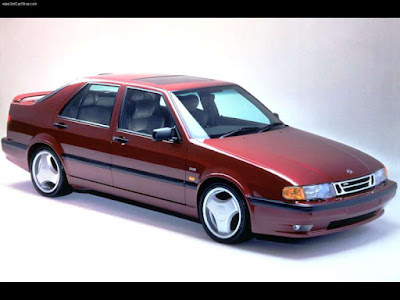







Saab 9000
The 9000, an automobile made by Saab, was released in 1984 for the 1985 model year (it was released in 1985 for the 1986 model year for North America). It was replaced by the Saab 9-5 in the spring of 1998.
The Type Four chassis, upon which the 9000 was based, was shared with the Fiat Croma, Lancia Thema and the Alfa Romeo 164. The Fiat and Lancia looked much like the Saab, but the Alfa Romeo only shared the chassis. Because they were very similar, many parts can be exchanged between the four cars regardless of brand. For example, the doors from the Fiat Croma fit directly on the 9000, but are lighter, due to less side impact protection. The windshield from the Croma can also be used on the 9000. The Cd value was 0.32. The design was by Giorgetto Giugiaro.
The original 9000 was a 5-door hatchback. A 4-door sedan version was later added (the 1988 CD) and, in 1992, the hatchback appearance was modified and modernised, in the CS version.
Because its platform was shared closely with three other cars, the Saab 9000's ignition key was situated on the steering column (like the Saab 95/96/97), instead of the Saab 99/900 location, between the front seats. The later 9-5, whose platform was shared with the Saturn L-series and some Opel models, returned the ignition back between the front seats.
For the first year, the only engine available was a watercooled DOHC 16-valve 4-cylinder engine with a turbocharger, at 1985 cc, giving 175 hp (129 kW). It was equipped with a computer display (the EDU, electronic display unit) showing actual and approximate fuel consumption, distance to an empty fuel tank, alternator output voltage, lowest battery voltage during engine start and the outside temperature. If the outside temperature fell to a range of 26° to 38 °F, the temp display is automatically selected to warn of possible 'black ice' road conditions. Later models added more trip computer functions to a separate display combined with the clock, including setting trip distances, arrival times, average speed, and excess speed alarms. A separate pictogram monitored oil pressure, showed open doors/hatch, and all exterior light bulbs in case of failures.
The wheelbase is 2.67 m (105 inches) on all models. Total length is 4.66 m (183 inches) on the original 9000. The 9000 CD's total length is 4.79 m (189 inches). The 9000 CS' total length 4.76 m (187 inches).
History
1984: 9000 prototype was shown in Europe
1985: 9000 started production and sale in Europe
1986: Introduction of a 2.0 L engine with 130 hp (96 kW). First year ever sold in the North America. The only engine combination sold in North America as a 1986 model year was the 2 L turbo / cat with the 5 speed. 160 hp, 185 ft·lbf torque. Motor Trend tested the 1986 9000 Turbo and achieved a 0-60 mph time of 6.6 seconds, one of the fastest sedans ever tested.
1987: Watercooling added to the turbo.
1988: Introduction of the CD model (four-door sedan/saloon) and the Talladega version (in recognition of the 1986 Long Run (see below). The 9000 CD was available only with a turbo engine equipped with a new and fully computerised electronic ignition system called Saab DI.
1989: Direct Ignition - an electronic ignition system was fitted to all turbo-charged engines
1990: Introduction of a 200 hp (147 kW) 2.3 L turbo engine.
1992: Introduction of the CS model (lowered headlights, redesigned hatch, etc).
1993: Introduction of the CS Aero/SPG, at the time, the most powerful and fastest Saab ever made (beaten in 1999 by the Saab 9-3 Viggen, the 2000 9-5 Aero, and the 2006 Saab 9-3 Aero and 9-5 Aero). The engine was a tuned 2.3 L turbo with 225 hp (165 kW) powered by a Mitsubishi TD04 turbocharger. The automatic transmission version had the same software and turbo (Garett T25) as the 2.3FPT producing only 200 hp (147 kW) due to the huge torque (252 ft·lbf/342 Nm) in the 5 speed. The Aero also had special 16-inch 'Super Aero' wheels and a lower ride height to improve handling. The Aero body-kit was fitted as standard to all Aero models.
1995: Introduction of the first V6 engine, a 3.0 L 54° non-turbo with 210 hp (154 kW).
1996: Introduction of the Ecopower engine, a 2.0 L turbo engine giving 150 hp (110 kW). The Ecopower was an electric preheating of the catalytic converter, giving lower emissions when starting the engine.
1997: Introduction of the Anniversary model (also known as Jubileum in Sweden), a special celebration model to honour Saab's 50th anniversary. The Anniversary came with special 8 spoke wheels, the body kit from the Aero and leather seats with the old Saab airplane logo on the back of the seat.
1998: After the Aero model was discontinued in 1997, all manual transmission-equipped 2.3 L Full Pressure Turbo models received the Aero's 225 hp engine.
In total, 503,087 Saab 9000s were manufactured.